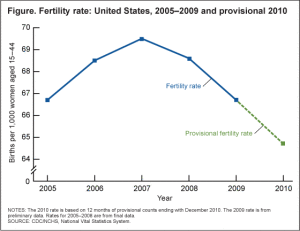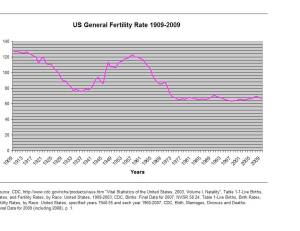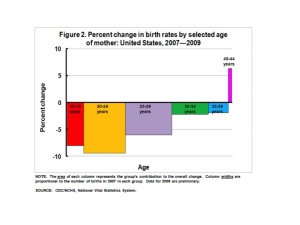Lately birth rates have been down: 2009 and 2010 birth data indicate that the US birth rate is diving under recession pressure (except for moms 40+), and 2010 Census data indicates that while the population has grown in the past decade, “new” minority kids (Hispanics, Asians, etc) have been born at a rate much higher than white kids, predicting a much browner future for America. Births to blacks are also down (though not as much as to whites).
In the wake of this news, we have two new books out calling for MORE BABIES. Bryan Caplan’s Selfish Reasons to Have More Kids: Why Being a Great Parent Is Less Work and More Fun Than You Think makes the case that parents overdo it with the intensive parenting – since twin studies show that nurture (apart from good enough provision of the middle class basics) plays a small part in the success and happiness rates experienced by adults. So we could all do less high-stress intensive care giving, which would make parenting more fun.
Caplan then reasons that, if having kids becomes more relaxed and fun, we should have more kids (risking losing the benefit of the relaxed parenting, one might guess, since basics provision actually does involve some effort and expense, which does expand with the number of kids). Because?? Because, long-term, they will give us more grandchildren when we’re old, and contribute more to our care and support. And, by the way, staff the jobs of the future. And, by the way, staff those jobs with white people, given that his audience is people who are having fewer kids. Population/environmental problems? We can solve them easily with a global carbon tax, Caplan reassures readers. No discussion of how to go about getting that global agreement in place.
Like Caplan, Kasey Edwards, in a book out in the UK but not yet in the US, addresses the fact that many people are finding it too hard to have kids, given the tradeoffs in the work world it often involves, and choosing either to have fewer or none. Her story, Thirty Something and the Clock Is Ticking – is set in Australia, where the birth rate is lower than in the US (1.78 TFR, vs 2.06). At 32 Edwards was told by her doctor that her endometriosis was wreaking havoc on her lady parts, and that she’d better act fast if she wanted a family. So she and her beau did that, employing IVF along the way, although kids had not been in their plans at that point. She now has a baby girl. While in the process of conceiving she (already the author of Thirty Something and Over It, a consideration of the disappointments of modern work) spoke with a lot of her fellow travellers, and other people with opinions about parenting (that gives you a pool of just about everybody). Her takeaway: people should start families sooner and find ways to fit kids into their lives in spite of the difficulties.
Since this book is not out here yet, I’ve had to rely on British reviews and Edwards’ website. They suggest that Edwards is interested in the complexity of people’s experience (there’s evidently a lot of consideration of why people might find the job of mothering less than attractive). But the book seems also to skew data on fertility toward the frightening (most people do not have end-game endometriosis at 32). “It’s really hard to get pregnant in your thirties,” says Edwards on Irish TV. But in fact that’s not true for most. Saying that women at 30 have a 22% chance of getting pregnant per month, and that by 35 it’s down to 18% sounds a lot worse than the more big picture data like – 7% of women who try do not get pregnant within one year at 30, 11% at 35, 33% at 40, 50% at 41, and 87% at 45. There is an obvious decline over time, and people need the facts, but it’s not necessary to alarm young women – except that alarm always makes good media fodder.
And could lead to the birth of babies sooner than their mothers would otherwise have thought of doing. Fine enough if they’re happy with that outcome, but there’s no attention paid in these texts to the workplace problems that lead women to hold back on kids nowadays to begin with. Women who start sooner are stuck with lower wages, and a slow down in the trickle up of women into policy making roles in government and business – the lack of which, circularly, creates the problems that women face at work….. And some people seem to think they have an interest in preserving that status quo.
Pronatalism (basically, promoting more births) serves a variety of purposes, which you may variously like or not – but be on the look out in the coming months for texts that claim to be pushing babies on you for your benefit. There may be other logics at work and groups seeking to benefit as well.
On related work/family ground, but from a different direction, I’m looking forward to reading Bossypants, by new later mom Tina Fey, now pregnant at 40 with baby 2, as soon as the semester sunsets.
Happy Mother’s/ Mothers’ Day everybody — moms and non-moms, dads and non-dads, as you like it.
And feel free to circulate copies of Ready: Why Women Are Embracing the New Later Motherhood among your friends and relations if you’ve already got your copy, to balance out the ever-present birth timing conversation.




